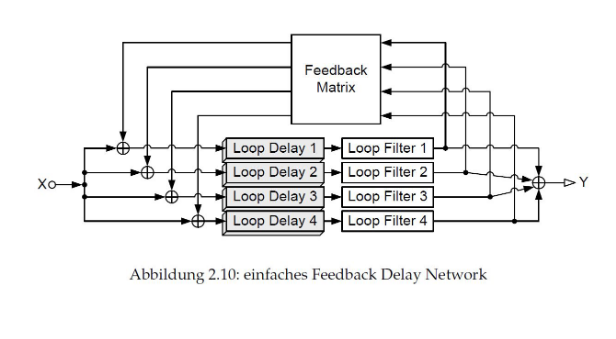Im about to program this structure in Matlab in a for loop

So far so good. And I have already done the for loop. I also implemented a Hadamard Mixing Matrix. Here is the code:
in = [ 1; 0 ]; % Dirac Impulse
Fs = 44100;
in = [in; zeros(3*Fs,1)]; % Space for reverb
% Define delay parameters
%Hadamard Matrix as feedback matrix
H = 0.75*hadamard(16);
feedbackGain =[0.1,-0.15,-0.2,0.25,-0.3,0.35,0.4,-0.45,-0.5,0.55,0.6,-0.65,-0.7,-0.75,-0.8,0.85]; %0.1,0.15,0.2,0.25,0.3,0.35,0.4,0.45,0.5,0.55,0.6,0.65,0.7,0.75,0.8,0.85
wetGain = [0.7,0.7,0.7,0.7,0.7,0.7,0.7,0.7,0.7,0.7,0.7,0.7,0.7,0.7,0.7,0.7]; % adjust to control wet signal level
% Convert delay time to samples
delaySamples = [101,233, 439,613, 853,1163, 1453,1667 , 1801,2053, 2269,2647, 3001,3607, 4153,4591]; %0.02s, 0.03, 0.04, 0.05 881, 1009, 1321,1511, 1777, 1999, 2203, 2351
%101, 439, 853, 1453 , 1801, 2269, 3001, 4153
%Summe delays = 30644
% delaySamples = [1200, 1800, 2200,2500];
% Create an empty array to store delayed audio
delayedAudio = zeros(size(in));
delayedAudio2 = zeros(size(in));
delayedAudio3 = zeros(size(in));
delayedAudio4 = zeros(size(in));
delayedAudio5 = zeros(size(in));
delayedAudio6 = zeros(size(in));
delayedAudio7 = zeros(size(in));
delayedAudio8 = zeros(size(in));
delayedAudio9 = zeros(size(in));
delayedAudio10 = zeros(size(in));
delayedAudio11 = zeros(size(in));
delayedAudio12 = zeros(size(in));
delayedAudio13 = zeros(size(in));
delayedAudio14 = zeros(size(in));
delayedAudio15 = zeros(size(in));
delayedAudio16 = zeros(size(in));
delayedAudios =[delayedAudio,delayedAudio2,delayedAudio3,delayedAudio4,delayedAudio5,delayedAudio6,delayedAudio7,delayedAudio8,delayedAudio9,delayedAudio10,delayedAudio11,delayedAudio12,delayedAudio13,delayedAudio14,delayedAudio15,delayedAudio16];
delayedAudios(1,:) = 1;
% Apply delay effect
for i = 1:length(in)-2*max(delaySamples)
for k = 1:16
if delayedAudios(i+delaySamples(k),k) == 0
delayedAudios(i+delaySamples(k),k) = feedbackGain(k)*delayedAudios(i,k);
end
end
for k = 1:16
for j = 1:16
if delayedAudios(i+delaySamples(j)+delaySamples(k),k) == 0 && k~= j
delayedAudios(i+delaySamples(j)+delaySamples(k),k) = H(j,k)*delayedAudios(i+delaySamples(j),j);
end
end
end
end
%Original and Mix together
for k = 1:16
delayedAudios(:,k) = wetGain(k)*delayedAudios(:,k);
end
%outputAudioM = delayedAudios(:,16) + delayedAudios(:,15) + delayedAudios(:,14) + delayedAudios(:,13) + delayedAudios(:,12) +delayedAudios(:,11) +delayedAudios(:,10) +delayedAudios(:,9)+delayedAudios(:,8) +delayedAudios(:,7) +delayedAudios(:,6) +delayedAudios(:,5) +delayedAudios(:,4) +delayedAudios(:,3) +delayedAudios(:,2 )+delayedAudios(:,1);
outputAudioM = sum(delayedAudios,2);
outputAudioM(1) = outputAudioM(1)*0.02;
%Low pass filtering + phase adjusting
d = designfilt('lowpassfir','FilterOrder',4 ,'CutoffFrequency',2000,'SampleRate', Fs);
y = filtfilt(d,outputAudioM);
% %Write the output audio to a new file and plot
audiowrite('output_audio_with_delay.wav', y, Fs);
plot(y);
% Play the output audio
sound(y,Fs);As you can see in the code I implemented a lpf AFTER the sound was computed. That of course is no problem but I have no idea how I can do that in the for loop like in the picture I showed. Can someone explain how it is to be done or give me hints?
NOTE:-
Matlabsolutions.com provide latest MatLab Homework Help,MatLab Assignment Help , Finance Assignment Help for students, engineers and researchers in Multiple Branches like ECE, EEE, CSE, Mechanical, Civil with 100% output.Matlab Code for B.E, B.Tech,M.E,M.Tech, Ph.D. Scholars with 100% privacy guaranteed. Get MATLAB projects with source code for your learning and research.
In general, in order to perform filtering and listen to the output inside your for loop, you use filter System objects to perform filtering, and audioDeviceWriter to play the output.
The application you are working with is somewhat similar to a reverberation object that ships with Audio Toolbox:
audioexample.FreeverbReverberator. That objects internally uses a bank of allpass filters implemented using dsp.IIRFilter objects.
Here is a simple sample code of how to use the object to filter input data and listen ot the output in the loop.
% Process samples from an audio file
afr = dsp.AudioFileReader("FunkyDrums-44p1-stereo-25secs.mp3",PlayCount=Inf);
% The filter
Comments
Post a Comment